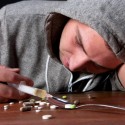Students learn firsthand effects of alcohol
Sometimes, field sobriety and breathalyzer tests given to someone under the influence of alcohol don’t lead to jail. Sometimes, they lead to gaining knowledge.
That was the case on Oct. 2, when a group of young people gathered at a friend’s house to learn about the effects of alcohol firsthand.
Oklahoma City Police Sgt. Greg Giltner joined a group of Pioneer reporters and friends to explain the effects of alcohol consumption.
Giltner said a typical DUI offender drives intoxicated 80 times within a year.
As of Oct. 8, he said, 2,081 people had been arrested for Driving Under the Influence of alcohol in Oklahoma City.
He said the average DUI arrest results in a person registering 0.15 blood alcohol content (BAC) blowing a breathalyzer test — almost double the DUI threshold of 0.08.
Giltner said no one is actually pulled over for drunk driving, but for traffic violations. Then, if an alcoholic odor or if other physiological signs are detected, field sobriety tests are given.
“Sixty-five percent of impaired drivers drive without headlights on,” he said. “Fifty-five percent straddle lanes.” He said officers also look for those following too closely and floating stop signs.
A person can practice walking the line or other field sobriety tests and get pretty good at it, Giltner said, but a person can’t hide the eye twitching that begins once a certain amount of alcohol has been consumed.
He said as soon as alcohol gets into the blood, a person will have horizontal gaze nystagmus — an involuntary twitching or jerking of the eye that varies from fast to slow when a person under the influence of alcohol looks from side to side.
“After a couple drinks their eyes will begin to noticeably twitch … ,” Giltner said.
“You can’t control the eyes from twitching.”
To prove his point, Giltner had two volunteers — one male, one female — perform the eye test. This is where a person’s eyes follow a pen from side to side.
As expected, he said, both participants’ eyes followed the pen back and forth “like marbles rolling across a glass table.”
Then, a two-part field sobriety test was administered. First, both participants walked a line heel to toe, counting aloud each step.
The second part consisted of each person lifting one foot six inches parallel to the ground and counting to 30 while Giltner timed them for 30 seconds.
Both were in complete control of their balance and motor skills during the initial tests, but that would soon change.
The first shot
The experiment began with each person drinking one shot — one-and-a-half ounces — of Crown Royal 80-proof whiskey.
Twenty minutes later, when the alcohol had time to take effect, Giltner administered a breathalyzer test.
Both participants registered well under the legal limit, with the male at 0.005 BAC and the female at 0.00 BAC.
“The breathalyzer measures the alcohol from your lungs,” Giltner said.
He said a breathalyzer machine is set up with a tank that simulates 210 liters per breath, which correlates with the lungs.
“So when someone blows into a breathalyzer, it’s the same as what your lung capacity is and breaks down the alcohol in your breath,” Giltner said.
“When someone has a 0.08 or a 0.16 (BAC), that’s per 210 liters a breath.
As an example, he told a story about a man who drank so much alcohol in one day he registered a 1.0 BAC.
“That means 10 percent of his blood was alcohol,” Giltner said.
The second shot
After Giltner administered the test, the participants took a second shot.
Once 20 minutes had passed, Giltner gave them the second field sobriety test of the evening.
Although both had performed the test flawlessly before taking their first shot, they struggled with it this time.
Giltner said during the field test, both participants’ eyes were “bouncy” when they looked right to left, the male’s more so than the female‘s.
Both walked heel to toe a little more cautiously and they showed slight difficulty performing the one-legged stance.
Once this was completed, a third shot was taken.
The third shot
Twenty minutes later, they blew into the breathalyzer again.
This time, the male registered a 0.022 BAC and the female registered a 0.019 BAC.
Then a third field sobriety test was given.
During the test, Giltner pointed out that as the participants walked heel to toe they moved noticeably slower. Both also became flustered as they counted their steps aloud.
During the one-legged test, the male wobbled and hopped around in order to keep his balance, while the female remained relatively stable.
Checking his watch, Giltner said both took longer than 30 seconds to count to 30 during this test.
The fourth shot
After the field test, both took one final shot. Twenty-five minutes later, breathalyzer and field tests were repeated.
The female blew a 0.053 and the male blew a 0.026.
The male’s BAC had climbed at a slow rate while the female’s had skyrocketed, Giltner said.
“Alcohol always affects women first,” he said.
He said that’s because alcohol goes to fatty parts of the body and women have an extra layer of fat in their pelvic area for childbearing.
The female participant said she was surprised.
“I had only been a 0.019 and then it jumped so high,” she said.
“And I was definitely surprised that I wasn’t at the legal limit because the way I felt is how I would stereotype someone who is too drunk to drive.”
During the final field test, although the male participant showed signs of impairment, the female participant showed definite signs of intoxication.
Giltner administered an additional test for the female where she tilted her head back with her eyes closed. She was asked to estimate the passage of 30 seconds and to put her head back down when she thought the time had elapsed.
The female swayed during the process and counted slower than the actual time.
Approximately 40 seconds passed before she put her head down.
“Alcohol (is) a depressant so her internal clock slowed down,” Giltner said.
Schooling the public
Giltner said people need to learn all they can about alcohol and its effects.
“Responsibility and knowledge is power,” he said.
“The more you know about how alcohol affects you, the more of a responsible drinker you can be.”
He said one misconception is that eating a lot will decrease the effect of alcohol consumption.
“It will not affect your BAC level,” Giltner said. “It just takes longer with food and delays the effects.
“Eighty percent of alcohol is absorbed into your blood stream, while 20 percent goes through your stomach lining. When it reaches your small intestine, that’s when you begin to get a buzz.”
Giltner said there is a lot of bad information about partying with alcohol.
“I hope this activity helps clear up some of the misconceptions,” he said.
Although neither the male or female participant hit the legal limit of 0.08 BAC, both showed a loss of control in their motor skills.
“I didn’t feel like I was out of control, but I definitely felt intoxicated,” the female participant said.
“If I was at an actual party, I probably would have only had another drink before I was done. But I definitely felt like I was drunk.”
source: Pioneer Online

